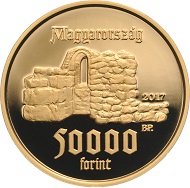March 9, 2017 – To mark the 775th anniversary of St. Margaret of Hungary, the Magyar Nemzeti Bank has issued a 50,000-forint gold coin and a 2,000-forint non-ferrous coin.
Hungary / 50,000 HUF / Au 986 / 6.982 g / 22.0 mm / Design: Enikö Szöllössy / Mintage: 2,000.
The obverse of the coin shows a view of the current ruins of the Dominican monastery on St. Margaret Island. The reverse features a profile of St. Margaret, based on the fresco of St. Margaret by Simone Martini in Assisi, Italy.
Hungary / 2000 HUF / Cu75Ni4Zn21 / 4.2 g / 22.0 mm / Design: Enikö Szöllössy / Mintage: 5,000.
Margaret (b. 27 January 1242 Klis, Croatia, d. 18 January 1270, Buda, Rabbit Island) was the 9th child of King Béla IV of Hungary and Maria Laskarina from the house of the Byzantine Emperor. Her mother was already pregnant with her when the Tatars broke through the defences at the Verecke Pass and overran Hungary under the leadership of Batu Khan in 1241. The King attempted to halt the Tatars on the banks of the Sajo River at the Battle of Mohi, but was defeated and fled to Dalmatia with his family. During this journey, in addition to the death of two of the royal couple’s children, the King’s brother Duke Coloman, one of the King’s most important supporters, also died. Amidst these hardships, the royal couple offered their unborn child to the service of God that their country may be spared devastation by the Tatars.
Saint Margaret of Hungary in a medieval book illustration.
At the age of three, Margaret was sent to the Dominican convent in Veszprem, where she received her education. Sister Olympiades was her tutor. At the age of ten, in 1252 along with her fellow nuns she moved to a monastery founded by her father on the Rabbit Island. It was here that she took her solemn vows in 1254 under the guidance of the newly elected prioress of the Dominican Order in Buda. Although she could have later had her vows dissolved with her father’s help, Margaret remained faithful to monastic life and refused the offer of marriage from King Ottokar II of Bohemia.
She is seen by Christians as a paragon of self-discipline and Christian love. Despite her royal birth, she gladly performed the lowliest work and wore the worst clothes. She spent her days working and her nights praying. According to the Hungarian legend copied by Lea Raskay in 1510, Margaret could also foretell the future, which was sometimes helpful in solving her father’s diplomatic problems. She died on 18 January 1270 at the monastery on the Margaret Island. Her tomb was carved from red marble with some white marble parts around 1271 by the Lombard sculptors Albert and Peter. Together with the Dominican Order, her older brother, Stephen V (1270-1272), called for her canonisation due to the miracles that occurred at her tomb and the rapid spread of veneration, with the process then actually starting in 1276. King Matthias also supported her canonisation, but the Catholic Church only declared Margaret a saint centuries later. Veneration of Margaret was officially allowed in Hungary from 1789, and finally Pope Pius XII canonised her in 1943, on 19 November, the feast day of her aunt, St. Elisabeth of Hungary.
For more information on coins from Hungary visit the website of the Hungarian Mint.
Here you can find some information on Saint Margaret and prayers and commemorations for her.









